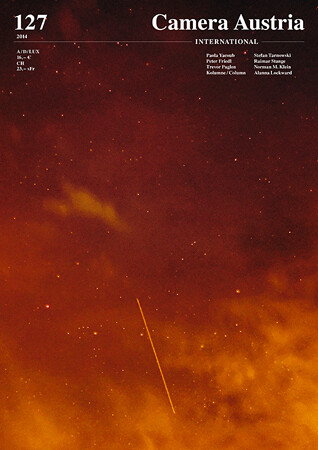Camera Austria International
127 out now
Featuring:
Stefan Tarnowski on Paola Yacoub
Raimar Stange on Peter Friedl
Norman M. Klein accompanying Trevor Paglen
Column: Alanna Lockward
The rose merchants in Paola Yacoub’s “Les fleurs de Damas” (The Flowers of Damascus, 2002) could be Syrian spies. What is visible on Trevor Paglen’s photographs cannot be definitively identified. Even the context-eluding newspaper photos in Peter Friedl’s “Theory of Justice” (1992–2010) are (no longer) self-explanatory. The artists presented in the current issue of Camera Austria International pose the fundamental question, among others, as to which strategies are used to achieve visualisation. What is actually visible? And to what extent does the visible correspond to the speakable? What happens when the pictures themselves want to become theory, as Peter Friedl wonders in the cover text of his book Theory of Justice 1992–2006?
“Les fleurs de Damas” was already created by Paola Yacoub in 2002, when Syrian forces occupied Lebanon and the country was controlled by the Syrian military intelligence. When Syria (officially) retreated from Lebanon in 2005, this control remained in place through various channels, even though less visible. “Men and sometimes children carry bunches of red roses in the streets of Beirut, in the Achrafieh neighbourhood, near Sassine Square. With these flowers they introduce unusual ornaments to the streets of Beirut. But nobody speaks to them, nor do they buy their flowers. And yet, every morning, they return to the same place with bunches of red roses. They always set themselves up in the same place, on the pavement, in front of a low, whitewashed wall, perfect for showcasing the flowers they display. In fact, everyone fears these ‘florists’ because they are strongly suspected of being members of the Syrian secret services.” (Stefan Tarnowski) The picturesque appearance of these rose merchants could simultaneously denote the presence of political and social control. “Les fleurs de Damas” are picture puzzles (“multistable images,” as W. J. T. Mitchell calls them) which show something that is visible and invisible at the very same time.
Between 1992 and 2010, under the title “Theory of Justice,” Peter Friedl compiled what he calls a “lyrical” collection of newspaper photos of protest campaigns that cover the entire geopolitical spectrum. These are photographs that Friedl also considers pictures of “public integrity and intimacy.” The title references the examination of the role of justice in a “well-structured society,” as pursued by the American philosopher John Rawls in his A Theory of Justice published in 1971. Aside from the fact that the regulation of civil rights and obligations within a liberal social contract has assumed the form of a full deregulation, “Theory of Justice” also deals with the question of the representation of justice. As Raimar Stange notes in his essay: “Unambiguity and ambiguity are thus adjacently readable across the surface of this photograph—in a state of reciprocal relativisation. And so it is that this Historienbild (“history painting” or, in our context, “history photograph”) of aforementioned overdetermination remains slightly open, as does its meaning.”
Trevor Paglen’s interest is focused on secret military or scientific facilities, laboratories, satellite systems, and so forth, that have been set up in remote areas or landscapes in order to elude the gaze—and thus the awareness—of the public. These insufficient (technical) means employed by Paglen in producing images of all facilities redouble their strategy of eluding pictures and/or visibility. In fact, this approach underscores the redoubling: military satellites moving across the nocturnal sky or military bases recorded with the strongest telephoto lenses from dozens of kilometres away. These photographs navigate the margins of abstraction and thus also identify, in a figurative sense, the limits of potentiality in creating a picture. At the same time, as Norman M. Klein writes, they represent a politics of secrecy, black budgets, and a neo-liberal, technological feudalism that aggravates inequality within society on an unprecedented scale.
Camera Austria International
published quarterly, 104–112 pages, German / English
Orders: www.camera-austria.at/shop
Cover: Trevor Paglen, KEYHOLE 12–3/ IMPROVED CRYSTAL (Optical Reconnais- sance Satellite Near Scorpio; USA 129) (detail), 2007. C-print, 121.9 × 152.4 cm. Courtesy the artist and Altman Siegel, San Francisco; Metro Pictures, New York; and Galerie Thomas Zander, Cologne.

